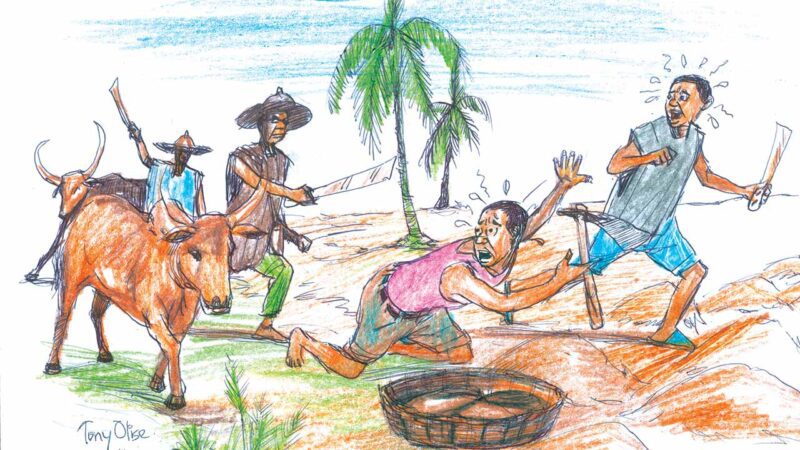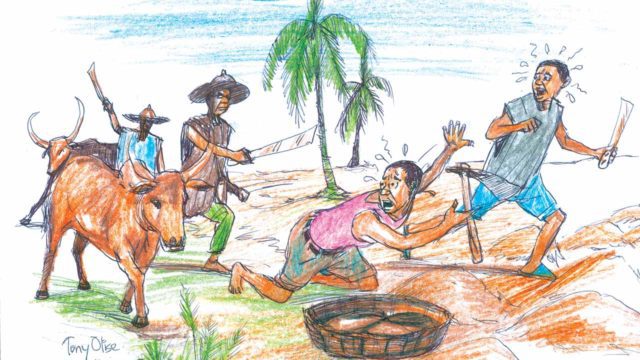National Issues
Herdsmen-Farmer Crisis: What is the real story? -By Teniola Tayo


According to research by Johns Hopkins University, from February 1992 to February 2016, over 5200 lives have been lost due to clashes between farmers and pastoralists in 24 states across Nigeria. On the other hand, according to Dr. Garus Gololo of the Miyetti Allah Cattle Breeders Association of Nigeria (MACBAN), almost 3000 herdsmen have been killed in these clashes.
Depending on who you’re speaking to, the conflict is either fundamentally attributed to the encroachment of herdsmen on farm lands, or the encroachment of farmers on grazing lands. This dichotomy of narratives brings us to the question: What is the real story?
The Fourth Deadliest Terrorist Group in the World
The Fulani Herdsmen militia have been ranked as the fourth deadliest terrorist group in the world by the 2015 Global Terrorism Index. Attacks that have been attributed to the herdsmen were initially contained within the North and North Central regions, but are now pan-Nigerian with reported attacks in the South and West of Nigeria.
It is apparent to anyone that this crisis is one that can potentially once again bring Nigeria to its knees. It is again obvious that Nigeria cannot afford for this to happen, especially with the ongoing conflict in the North-East and the resurgent conflicts in the South-East and South-South. Also, the increasing sparseness of public funds as a result of the declines in oil prices, oil production and the general decline in Nigeria’s productivity mean that these limited resources cannot be diverted to fund another war.
The herdsmen-farmers crisis has to be resolved permanently and effectively. This is a fact. However, how can this be achieved?
The Danger of Too Many Stories
It can be argued that to find a solution to a problem, one must first have a clear picture of what the problem is. By extension, in order to find a solution that appeals to all stakeholders to the problem, it is important for these stakeholders to agree on what the problem is.
There are a multitude of narratives regarding the Herdsmen-Farmers crisis. H.E Atiku Abubakar shared at an event that took place in Abuja in May 2016 that the herdsmen crisis was said to be partly caused by herders that had sold off the cattle they were custodian off and squandered the proceeds. These herders then resorted to criminal activity such as kidnappings to get more money to maintain their lifestyles. These offshoot narratives are numerous, but can all be traced to one cause.
What is the Real Story?
At the centre of the herdsmen crisis, from whatever angle you look at it, is access to grazing land. This has become a problem especially as a result of climate change, increase in human population, increase in livestock population, and poor agronomic practices.
What Do The Herdsmen Want?
It is important to note at this point, that the herdsmen usually own only a small fraction or even none of the cattle that they herd. These cattle usually belong to influential cattle breeders which include politicians, top-level civil servants and other wealthy Nigerians. These cattle breeders have a representative association known as the Miyetti Allah Cattle Breeders Association of Nigeria (MACBAN). The Jamu Nati Fulbe Association, on the other hand, is more focused on the herdsmen themselves and was formed to enlighten the nomadic herdsmen on the importance of living peacefully with their host settlers. “Jamu Nati Fulbe” is said to mean “Peace has returned for the Fulanis.”
The Miyetti Allah issued a recommendation signed by its National Secretary listing some requests to the Nigerian Government that they believe, if met, will minimize the clashes between herdsmen and farmers. The requests can be summarized as follows; The Federal Government and relevant MDA’s should demarcate and preserve grazing routes; create a comprehensive Livestock Development Action Plan; Establish a Federal Ministry for Livestock Development; Provide funding for grazing reserves development; Close monitoring and detection of trans-boundary movements, trans-boundary animal diseases; Undertake livestock census and carrying capacity of grazing reserves and grazing areas; Provide intervention fund for the development of comprehensive livestock production including ranch acquisitions, grazing reserves and stock’ routes both in the short, medium and long term and provide training and capacity building for pastoralists.
The group however, refused the Federal Government’s suggestion to set up cattle ranches as an alternative to nomadic grazing.
Proposed Solutions
Grazing Reserves: The most obvious solution to this challenge, that also appears to be within the reach of the government of Nigeria is the setting up of grazing reserves along the grazing routes of the herdsmen. However, this proposal is not widely accepted by all stakeholders, as it plays into the suspicions of those who believe there is a Fulani agenda to Islamise or subjugate the rest of the country. Also, over 70 percent of 415 existing grazing reserves previously set aside by the federal government are still yet to be developed, or have been diverted to other uses. In addition, sedentary farmers in various parts of Nigeria believe that setting aside grazing reserves for the herdsmen amounts to giving them preferential treatment.
Cattle Ranches: The establishment of cattle ranches has also been proposed as a potential solution to the problem. The Federal Minister of Agriculture and Rural Development, Audu Ogbeh, recently proposed that grass would be imported for the ranches from overseas as is done in other high output cattle rearing countries like Saudi Arabia. However, the Miyetti Allah has rejected this proposal, opting instead for the establishment of grazing reserves. Again, a study conducted by Ismail Iro on cattle ranching in Nigeria concluded that the past efforts by the federal government to set up these ranches were mostly a failure as the ranches became huge financial, environmental and health disasters.
Way Forward
Would it be possible to find some middle ground between the establishment of grazing reserves and the establishment of cattle ranches that would be accepted by majority of the stakeholders? The only way to find this out will be to ask them. There is a need to convene a series of dialogue sessions with these stakeholders using comprehensive research work on all the available options as a backdrop. The objective of these discussions would be to arrive at solutions that have been created by the parties involved, rather than imposed on them. This is the only way to ensure that the solution is lasting and would be truly effective.

















